Water risk management
We use about 6.0 billion m3 of industrial water a year.
Throughout the company, approximately 90% of the water is derived from recycled or reused water to reduce wastewater discharge, at all of our steelworks and factories combined. We try not to waste precious water resources, and to minimize wastewater discharge. To achieve this, we make daily efforts to maintain and improve the performance of wastewater treatment equipment, and the inspection and control of wastewater quality.
Our operational bases in Japan are evaluated by the World Resources Institute (WRI) Aqueduct to confirm that we are not prone to high-level water stress.
Nevertheless, in preparation of the remote chance of a water intake restriction, some of our steelworks, such as the Yawata area of Kyushu Works, possess their own water reservoir. In certain circumstances, we contribute to easing water stress of the community by providing water for agricultural use or by cooperating in other ways.
In our ongoing nature-related risk and opportunity analysis, we evaluated 26 major overseas iron ore and coking coal suppliers by using tools such as IBAT (Integrated Biodiversity Assessment Tool) and Aqueduct, and identified 7 sites in regions with high impacts on “water resources” and “terrestrial ecosystems”.
In the future, we will evaluate the identified impact and consider engaging with suppliers to reduce their impact on natural capital, including water resources.
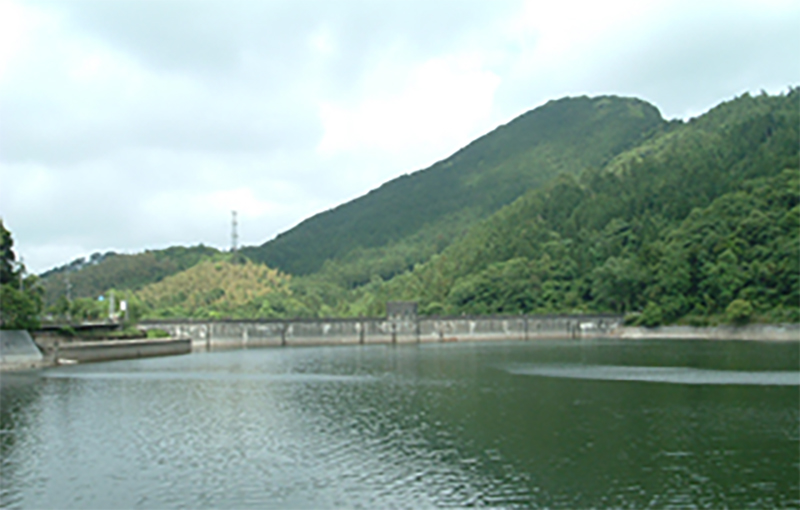
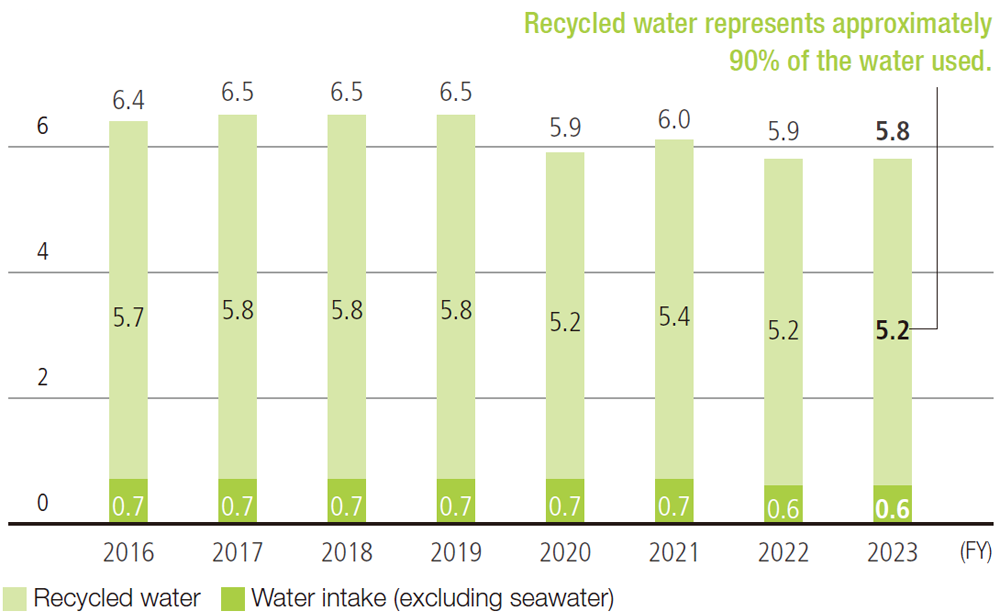
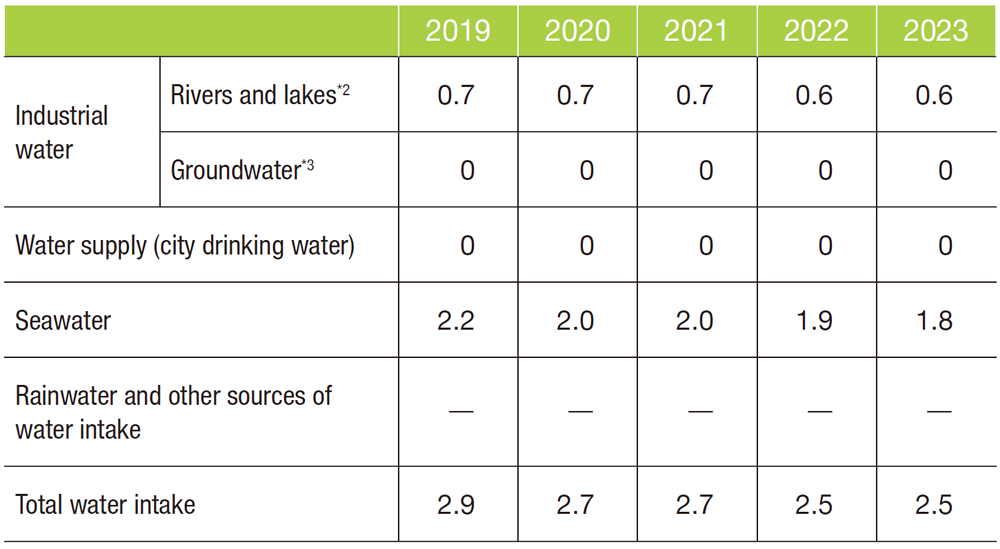
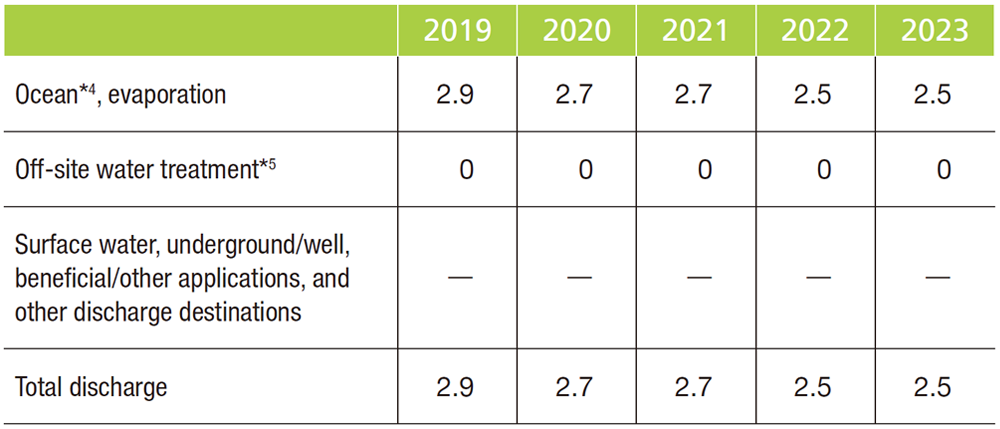
*1 Boundary of data collection: Nippon Steel (domestic manufacturing bases and Research & Engineering Center)
*2 The amount of water taken from the company’s reservoirs is included in “Rivers and lakes (industrial water).”
*3 Some workplaces have taken water from groundwater, which is less than 0.3% of the total.
*4 Water discharge is treated appropriately according to water quality and discharged in compliance with water discharge standards.
*5 Other than the ocean, water treatment (sewerage) outside the site is less than 0.01% of the total.
Compliance with the Water Pollution Control Law and conservation of water quality in the discharge area.
In consideration of the importance of complying with the Water Pollution Control Law and conserving the water quality in the sea area to which it is discharged, we ensure that in the event of an operational problem the drainage outlets will not release abnormal water discharge outside the steelworks.
Water drainage automatic monitoring systems, water shutoff gates, emergency reservoirs, etc. are installed to prevent water pollution. We also strive to check, repair, and maintain equipment in order to prevent water pollution, and to train our personnel in methods of checking of operations and controlling work procedures.
Moreover, our steelworks have taken measures, such as to install a large storage tank so that water tainted with iron ore powder would not directly be released into the sea even if our steelworks were struck by a local torrential rain caused by weather abnormality. If there is a crack in an embankment facing the sea, there is a risk of a leakage of groundwater with unknown contaminants. In order to prevent this, the embankment is regularly inspected from the sea side enabling us to maintain and manage it in a sound condition. In areas with potential risk of leakage of water which may exceed permissible levels of contaminants, boards or a sheet water barrier may be installed so as to prevent leakage even if a crack develops on the embankment.
Measures to prevent the reoccurrence of environmental incidents in the Kimitsu Area of the East Nippon Works
In the Kimitsu Area of the East Nippon Works, colored effluent containing coke gas desulfurization liquid flowed out from our sites in June 2022, and, between June 30 and July 2, the draining of effluent that exceeded the effluent standards was found to have occurred at Effluent Outlet No. 7. Furthermore, our subsequent internal investigations identified the draining of effluent that exceeded the regulatory values at other effluent outlets and drainage channels and our inappropriate treatment of water quality measurement results. We sincerely apologize for the significant concern and inconvenience to nearby residents, municipal authorities, and all other stakeholders caused by these incidents. We fully recognize the seriousness of this matter. We are thoroughly taking measures to ensure such incidents will not occur again, based on our investigation of causes and evaluation of countermeasures.
1. Concerning the incident of colored effluent outflow
In June 2022, desulfurizing liquid leaked from a repaired section of a tank that temporarily stores coke gas desulfurization liquid. The colored effluent overflowed above a dike surrounding that tank, inflowed into drainage systems via the rainwater collection side ditch and the underground passage and flowed out from our sites. The tank had undergone overhaul inspections and wall thickness measurements as well as daily and monthly inspection and it had been repaired accordingly, however, this could not prevent the leakage that occurred this time. In response to this incident, we have decided to implement thorough countermeasures to prevent reoccurrence via a three-tiered approach: “no leaks,“ “no inflow into drainage systems even if a leak occurs,“ and “shutting-off of leaks within drainage systems.“ This involves not only renewal of the desulfurization liquid tanks, but also installation of dikes, and shutting off the drainage system, and other measures.
2. Concerning the draining of effluent exceeding the effluent standards via Effluent Outlet No. 7
In response to the colored effluent outflow incident, we conducted daily water quality measurement at all effluent outlets. As a result, between June 30 to July 2, we found that the effluent at Outlet No. 7 indicated measured values of cyanide and total nitrogen exceeding the effluent standards, which was attributable to the dust collection water for a blast furnace. Furthermore, during this investigation into the causes, we found effluent discharge had been conducted using methods different from those in the notification to the authorities, such as the redundant water generated in the dust collection system of the blast furnace being sent to a different drainage system utilizing a temporary pump. We also identified the existence of multiple temporary pumps and cyanide treatment facilities not described in the notification to the authorities. It can be inferred that the draining of effluent that exceeded the effluent standards at Effluent Outlet No. 7 described above occurred because one of these pumps fell off and pumped out redundant water while agitating and dispersing sludge with a high concentration of cyanide.
We have removed all the temporary pumps that were not notified to the administrative agencies. In addition, we are carrying out dual measures for cyanide treatment by reinforcing and renewing the treatment equipment in the dust collection system of the blast furnace.
3. Concerning the incident identified from voluntary thorough inspections
As a result of a voluntary comprehensive inspection that we conducted in response to the incident described above, we found that there were unreported cases of exceeding the effluent standards and the values agreed upon with municipal authorities at multiple effluent outlets and drainage channels. This included the cases where, in statutorily required measurements at Effluent Outlet No. 16, in cases where measurement results had exceeded the effluent standards for cyanide and total nitrogen, such measurement results were not reported to the administrative agencies concerned. Instead, additional sample collection was conducted, and the measurement results that fell within the effluent standards were recorded and stored as the statutorily required measurement results. Also, the cases we found included where, in measurements other than the statutorily required ones at Effluent Outlet No. 16, the draining of effluent exceeded the effluent standards for cyanide and total nitrogen, but had not been reported to the administrative agencies concerned.
Presently, we are implementing the same dual measures for cyanide treatment for this dust collection system of the blast furnace as described under heading 2 above, in addition to installing equipment to prevent water overflow.
4. Issues with mindset, issues with organizational/operational systems, and countermeasures to prevent reoccurrence
We consider that the causes of these incidents include mindset issues, such as misconceptions about statutorily required measurements and notifications under the Water Pollution Prevention Act, insufficient sharing of risks with supervisors and other departments, and insufficient dissemination of the awareness regarding environmental compliance among those involved in water treatment operations; and issues with organizational and business operation structures, including the structure related to blast furnace dust collection water treatment and business operations related to water quality measurement. Therefore, we are implementing the following measures to prevent the reoccurrence of these incidents.
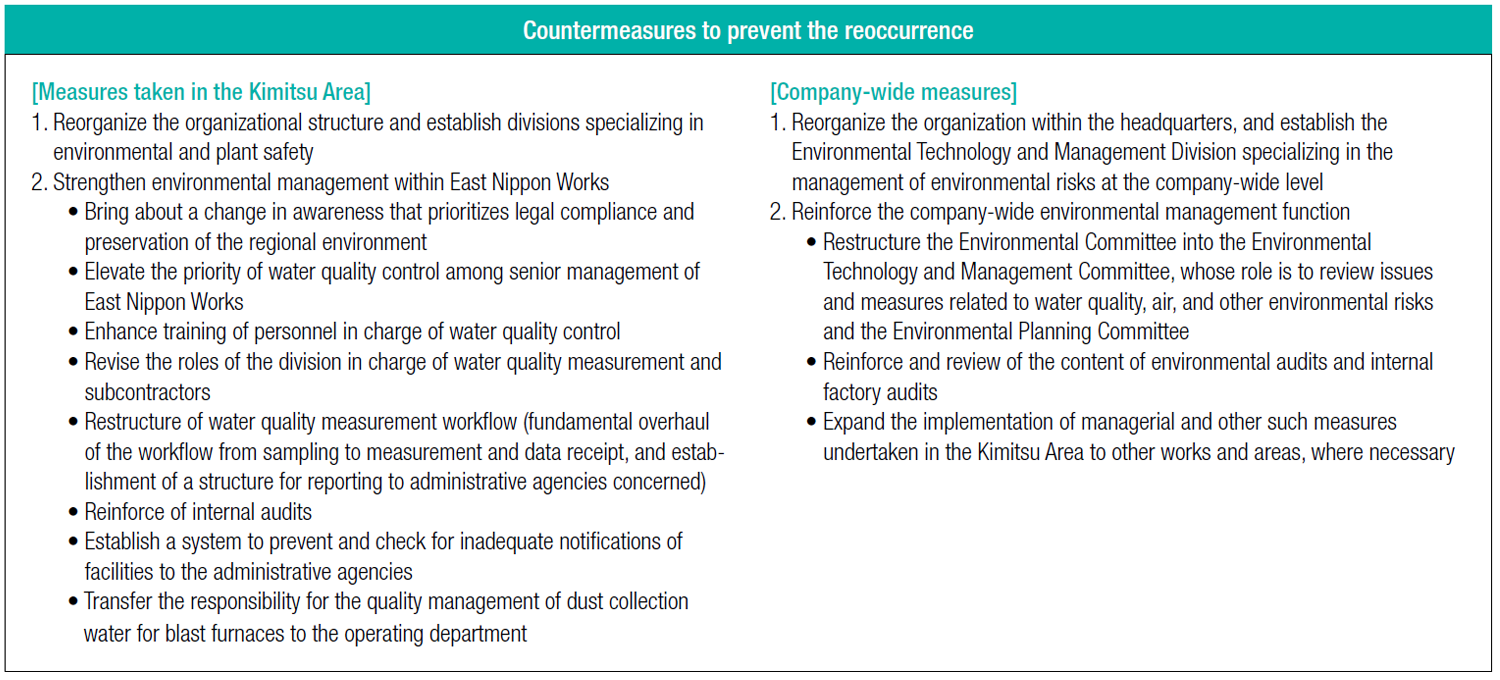
For more information about this matter, please refer to the press release.https://www.nipponsteel.com/en/news/
- Submission of the Report on the Effluent Incidents at Kimitsu Area of East Nippon Works (September 30, 2022)
Addressing water risks: Installation of liquid barriers

Tanks and a liquid barrier See details:
*If you are viewing this document on a smartphone, enlarge the figure and use it.
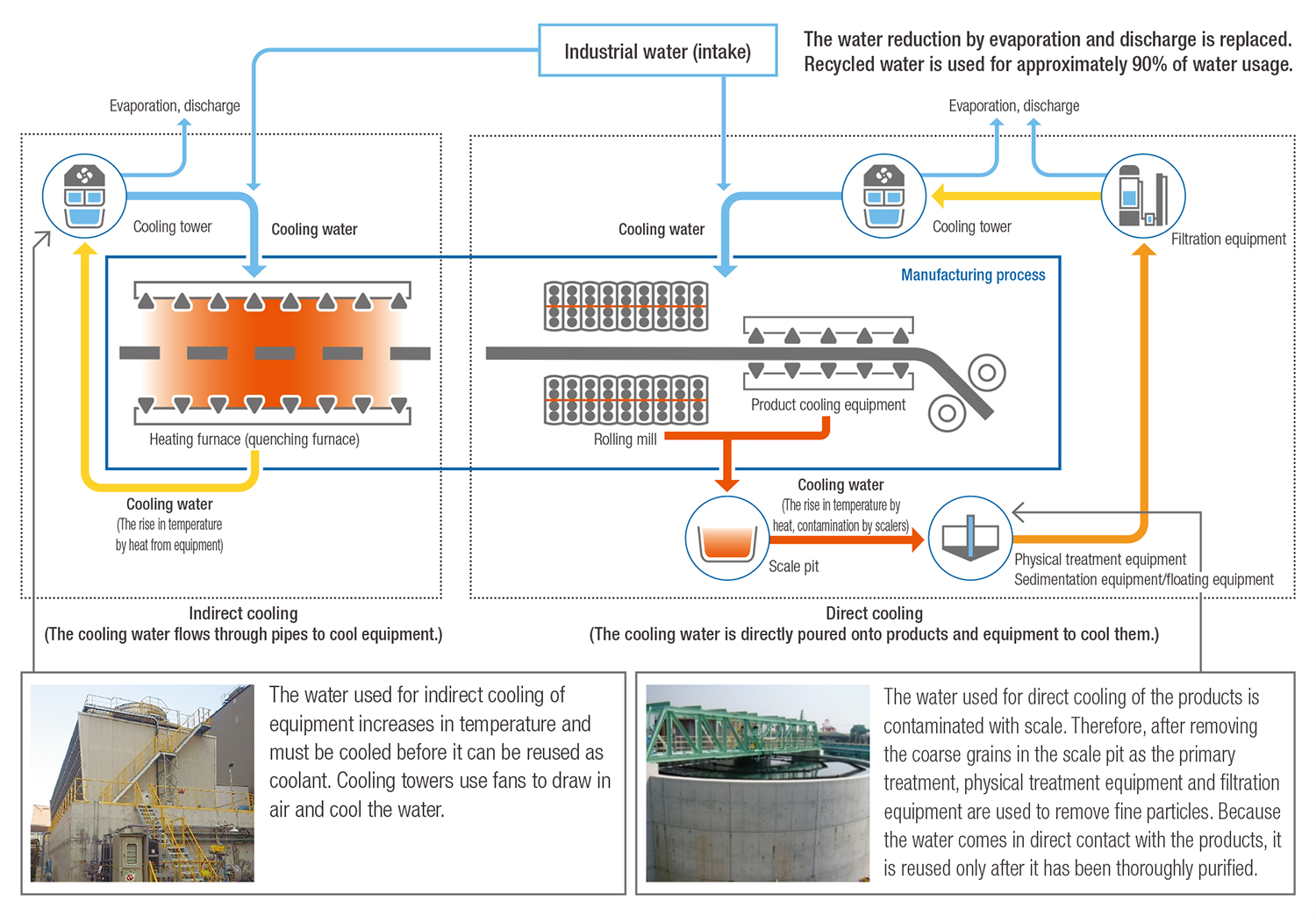
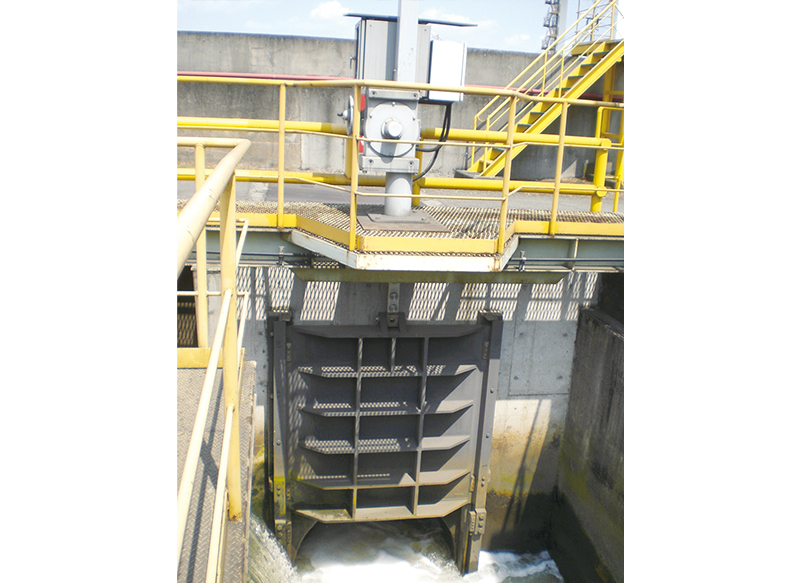
(Setouchi Works Hirohata Area)
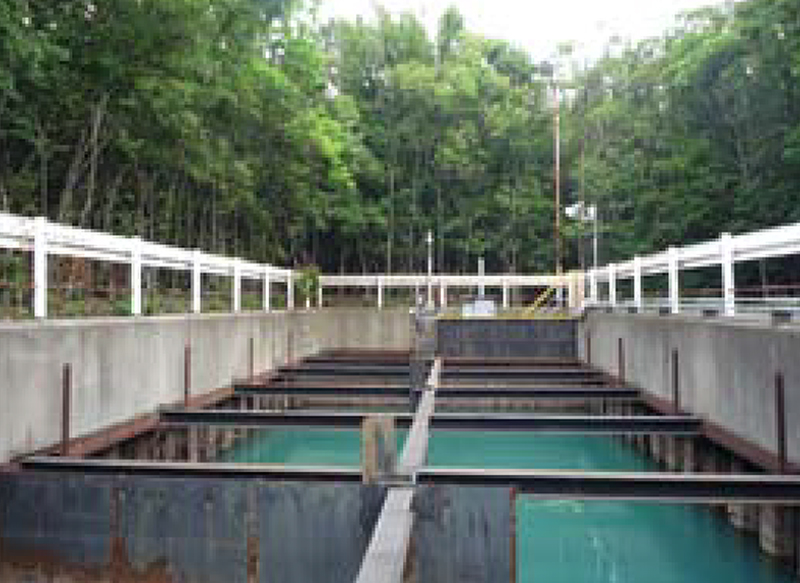
(Sakai Works)
Environmental measures at steelworks
Water purification; prevention of abnormal waste water
Waste water coagulating sedimentation treatment equipment
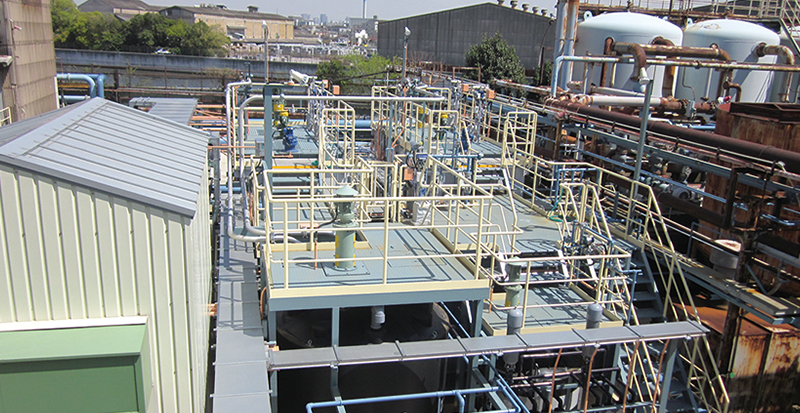
Fine undissolved matter is coagulated into bigger masses by chemical treatment, permitted to settle, and is removed.
Pressurized flotation system
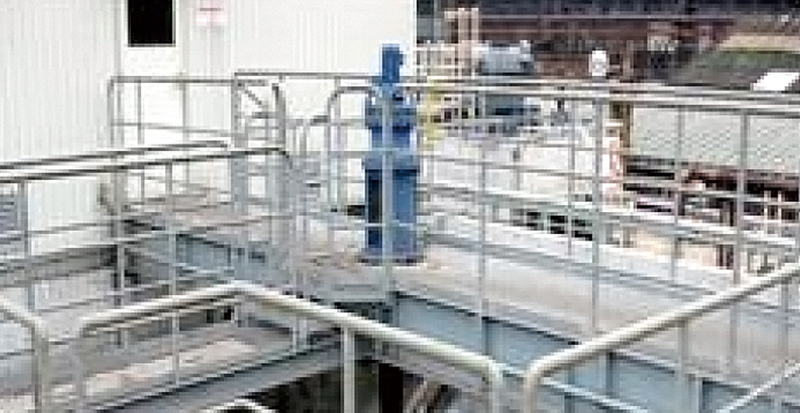
Floating oil is removed by tiny bubbles formed by released air.
Activated sludge treatment equipment
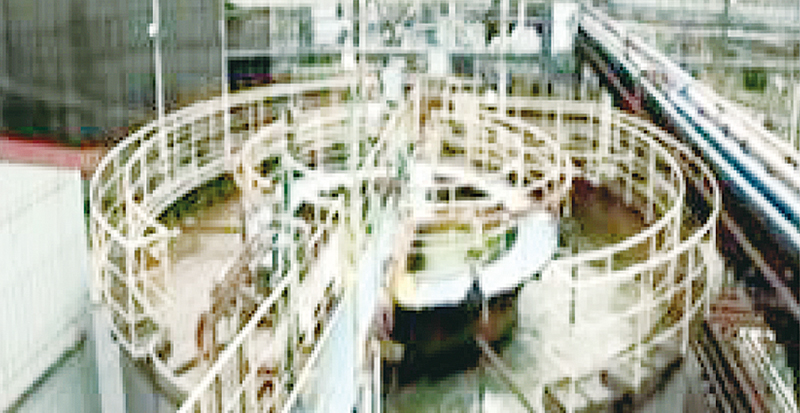
Organic matter is decomposed and eliminated by bacteria.
Filtration equipment (secondary treatment)
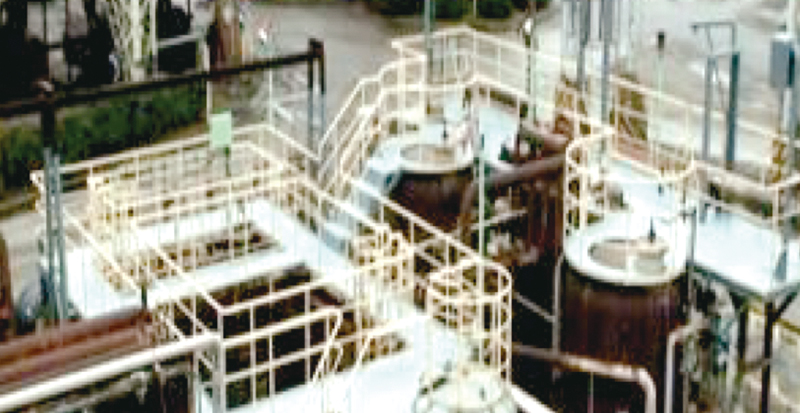
Undissolved residues in the treated waste water are filtered by a sand layer and removed.
Waste water automatic monitoring equipment
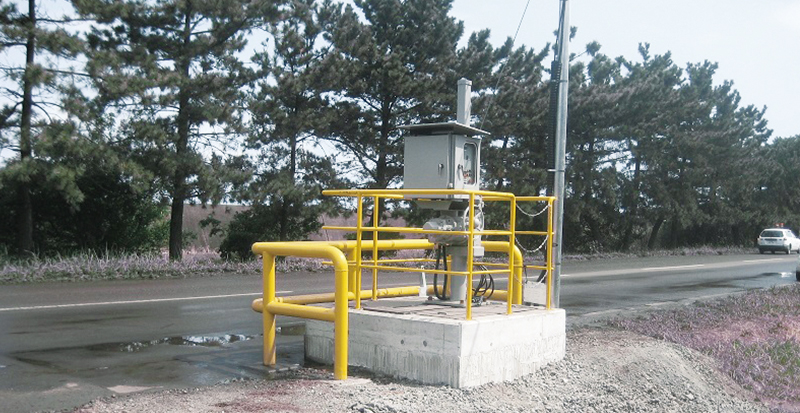
The water quality of waste water is automatically monitored.
Waste water closing gate
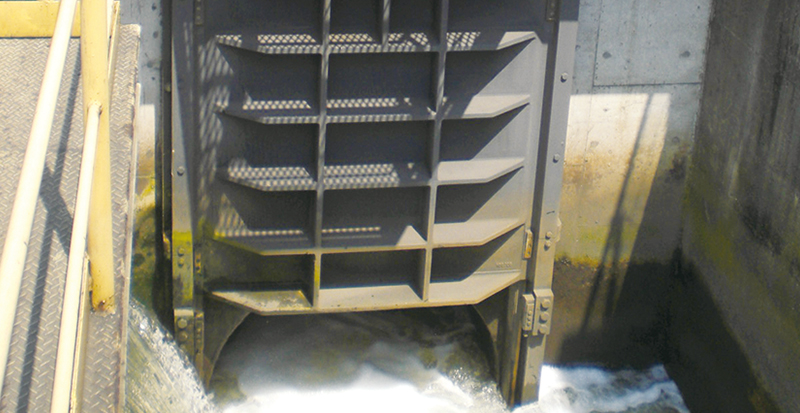
Waste water flow is shut in case of trouble.
Rainwater effluent treatment facility
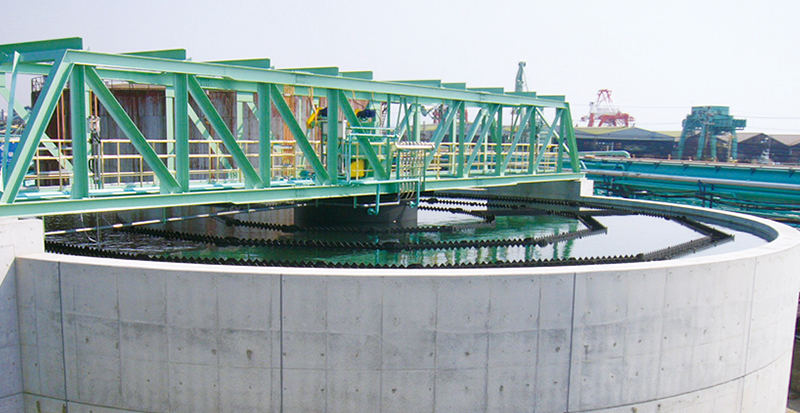
Undissolved residue from rainwater is coagulated and eliminated.
Checking of embankments
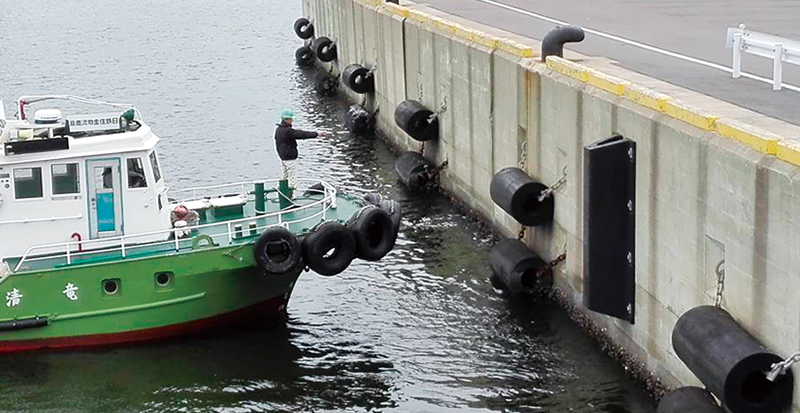
The embankments are regularly inspected from the sea side to find potential issues.
Repair of the damaged area of embankment
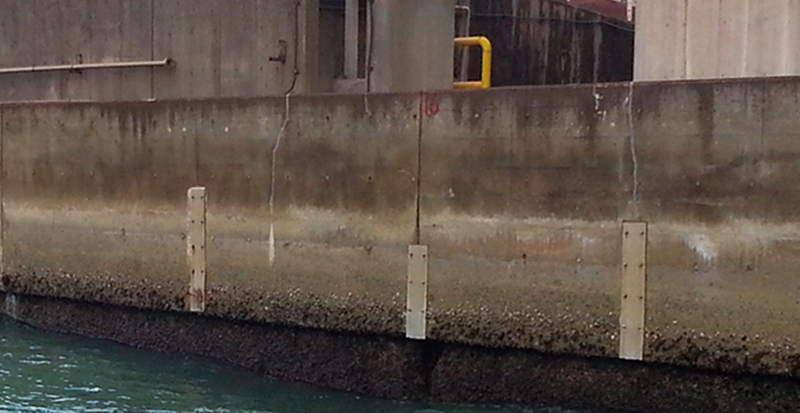
Damaged areas found by inspection are promptly repaired to maintain and manage the embankment in a sound condition.
